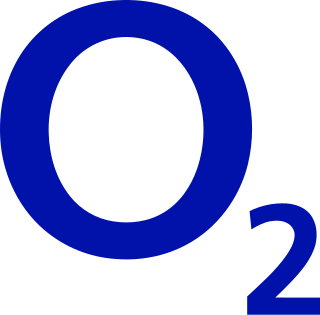The Universal Mobile Telecommunications System (UMTS) is a 3G mobile cellular system for networks based on the GSM standard. Developed and maintained by the 3GPP, UMTS is a component of the International Telecommunication Union IMT-2000 standard set and compares with the CDMA2000 standard set for networks based on the competing cdmaOne technology. UMTS uses wideband code-division multiple access (W-CDMA) radio access technology to offer greater spectral efficiency and bandwidth to mobile network operators.
Multimedia Messaging Service (MMS) is a standard way to send messages that include multimedia content to and from a mobile phone over a cellular network. Users and providers may refer to such a message as a PXT, a picture message, or a multimedia message. The MMS standard extends the core SMS capability, allowing the exchange of text messages greater than 160 characters in length. Unlike text-only SMS, MMS can deliver a variety of media, including up to forty seconds of video, one image, a slideshow of multiple images, or audio.

NTT DoCoMo's i-mode is a mobile internet service popular in Japan. Unlike Wireless Application Protocols, i-mode encompasses a wider variety of internet standards, including web access, e-mail, and the packet-switched network that delivers the data. i-mode users also have access to other various services such as: sports results, weather forecasts, games, financial services, and ticket booking. Content is provided by specialised services, typically from the mobile carrier, which allows them to have tighter control over billing.

SoftBank Group Corp. is a Japanese multinational investment holding company headquartered in Minato, Tokyo which focuses on investment management. The group primarily invests in companies operating in technology that offer goods and services to customers in a multitude of markets and industries ranging from the internet to automation. With over $100 billion in capital at its onset, SoftBank's Vision Fund is the world's largest technology-focused venture capital fund. Fund investors included sovereign wealth funds from countries in the Middle East.

Vodafone Group Plc is a British multinational telecommunications company. Its registered office and global headquarters are in Newbury, Berkshire, England. It predominantly operates services in Asia, Africa, Europe, and Oceania.

Freedom of Mobile Multimedia Access (FOMA) is the brand name of the W-CDMA-based 3G telecommunications services being offered by the Japanese telecommunications service provider NTT DoCoMo. It is an implementation of the Universal Mobile Telecommunications System (UMTS) and was the world's first 3G mobile data service to commence commercial operations.

In Japan, mobile phones became ubiquitous years before the phenomenon spread worldwide. In Japanese, mobile phones are called keitai denwa (携帯電話), literally "portable telephones," and are often known simply as keitai (携帯).

Vodafone Ireland Limited, a wholly owned subsidiary of Vodafone Group, is a mobile phone network, broadband and TV provider in Ireland. It was created when the Vodafone Group bought Eircell, the mobile arm of Telecom Éireann. As of September 2019, Vodafone has 26% of broadband subscribers, and 43% of mobile phone subscribers.
Sha-Mail was a 2G mailing and picture messaging service launched by J-Phone in 2000 that allowed users to take a photo with their mobile phone and send it to another user on the service as an email attachment. A related service introduced in 2002, Video Sha-Mail, let users record and send videos as well. Sha-Mail was widely successful upon its launch, became a household name in Japan, and sparked a boom in camera phone services worldwide. The term derives from sha, the first part of the Japanese word shashin, and mail.
Vodafone Limited, trading as Vodafone UK, is a British telecommunications company, owned by Vodafone Group, the world's eighth-largest telecommunications company. Vodafone is the third-largest mobile network operator in the United Kingdom, with 18.5 million subscribers as of July 2024, after O2 and EE, followed by Three. The country's first cellular phone call was made on the Vodafone network in 1985.
Mobile content is any type of web hypertext and information content and electronic media which is viewed or used on mobile phones, like text, sound, ringtones, graphics, flash, discount offers, mobile games, movies, and GPS navigation. As mobile phone use has grown since the mid-1990s, the usage and significance of the mobile devices in everyday technological life has grown accordingly. Owners of mobile phones can now use their devices to make photo snapshots for upload, twits, mobile calendar appointments, and mostly send and receive text messages, listen to music, watch videos, take mobile pictures and make videos, use websites to redeem coupons for purchases, view and edit office documents, get driving instructions on mobile maps and so on. The use of mobile content in various areas has grown accordingly.

The BlackBerry Pearl was a series of smartphones developed by Research In Motion, and was the first BlackBerry device with a camera and media player. It was originally released on September 12, 2006. T-Mobile was the first US carrier to release the phone as a carrier device. The last BlackBerry Pearl released was the 9100 series on May 13, 2010. After this model was cleared out, RIM discontinued the Pearl series.

Wireless Application Protocol (WAP) is a now obsolete technical standard for accessing information over a mobile cellular network. Introduced in 1999, WAP allowed at launch users with compatible mobile devices to browse content such as news, weather and sports scores provided by mobile network operators, specially designed for the limited capabilities of a mobile device. The Japanese i-mode system offered another major competing wireless data standard.
On-Device Portals (ODPs) allow mobile phone users to easily browse, purchase and use mobile content and services. An ODP platform enables operators to provide a consistent and branded on-device experience across their broadening portfolio of services and typically provides on-device catalogs of content for purchase, deep links to WAP portals, customer care functionality, and rich media services such as full track music, TV and video.

Hutchison 3G Enterprises S.A.R.L., trading as 3 (Three) and Hutchison 3G, is the owner of several originally UMTS-based mobile phone networks and broadband Internet providers, which operate in Hong Kong, Macau, Austria, Denmark, Indonesia, Ireland, Italy, Sweden, and the United Kingdom.
Novarra was a mobile internet software company founded in 2000 and based in Itasca, Illinois, United States. It created web-based services such as web internet access, portals, videos, widgets and advertising for mobile devices. Novarra provided access to the internet and other services through wireless handsets, PDAs and laptops and sold directly to operators, mobile handset manufacturers and internet brand companies. In 2010, Nokia acquired 100% of Novarra's shares.

The Japanese mobile phone industry is one of the most advanced in the world. As of March, 2022 there were 199.99 million mobile contracts in Japan according to the Ministry of Internal Affairs and Communications. This is 158 percent of Japan's total population.

Telefonica UK Limited, trading as O2 (stylised as O2), is a British telecommunications services provider, headquartered in Reading, England which operates under the O2 brand. It is owned by VMED O2 UK Limited, a 50:50 joint venture between Telefónica and Liberty Global. O2 is the UK's largest mobile network operator, with 23.8 million subscribers as of July 2024.
Yospace is a digital video distribution company. Its technology allows live and on-demand video content to be taken to connected devices such as smartphones, feature phones, tablets and to web browsers with user-targeted ad insertion.

Hutchison 3G UK Limited, trading as Three UK, is a British telecommunications company based in Reading, England. It is an indirect, wholly-owned subsidiary of CK Hutchison Holdings, a limited liability Cayman Islands company registered and listed in Hong Kong. Three is the fourth-largest mobile network operator in the United Kingdom, with about 10.6 million subscribers as of May 2024.












